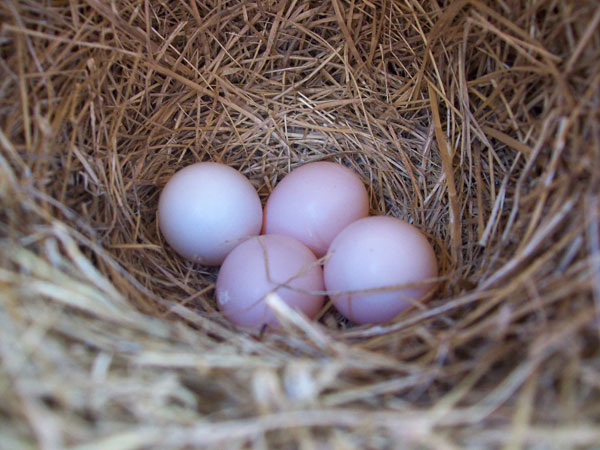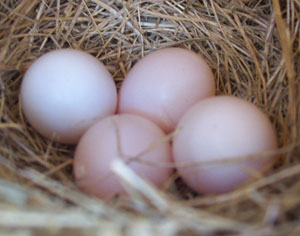Not All Bluebird Eggs are Blue – Some are Pink!


A small percentage of bluebird eggs are white. Some of the “white” eggs have a pink tinge.
Norma Guidetti indicated that when she saw these eggs in the box, she didn’t even think they were bluebird eggs. This is the female’s fourth attempt to nest in this box. The other three clutches were also pinkish. Predators got previous eggs (no more than 2 were found before they disappeared. The nestbox is mounted on a pole which is greased. Possible predators might be snakes or large birds, as the nest was not disturbed.)
Norma said she has been bluebirding for 18 years, but this is the first time she’s seen pinkish colored eggs.
I have seen Tree Swallow eggs that were distinctly pink (see photo.) White bluebird eggs sometimes have a pinkish caste, but these are REALLY pink! Ann Wick has also see entire clutches of pink bluebird eggs on occasion. Leah of Florida also took a great photo of a clutch of pink eggs (see photo.) Pink eggs would be expected to look the same inside as blue or white eggs. (And no, pink eggs don’t hatch into girl bluebirds.)
I asked bluebird expert Keith Kridler why some eggs might be pink. He said “I am just guessing that these egg shells would be thinner than normal if she were able to measure one of the shells. I am guessing that part of the pink tinge to these is actually coming from light going through the thin shell and then the light is bouncing back off the egg yolk giving them this glow. Again I am just guessing but the female just could not pull enough calcium from her diet and body to form thicker more solid colored eggs.” It would be interesting to see if there were any change if her diet was supplemented with calcium (either by dusting mealworms or adding calcium sources to suet.)
Steve from Merced, CA noted that Red-shafted Flickers lay pink eggs that look transparent. After a week of being incubated they turn a pale whitish color, losing most or all of the pinkish color, and they no longer look transparent. IF the egg shells are thin and the pink is coming from the light being reflected from inside the eggs, then as the chicks develop they should lose the pink tinge.
Norma provided an update on 7/24/09. All of the eggs hatched. She noted that “During the last week, the eggs were not as pink as when first laid but definitely still had a pinkish hue.”
Related topics:
- Weird eggs
- White bluebird eggs
- Not all blue eggs are bluebird eggs (American Robin nest photos)
- Photos of typical bluebird nests, eggs and young
- Monitoring
- Eastern Bluebird nesting biology (all about)
- The Amazing Egg
Previous Pictures of the Week: © Original photographs are copyrighted, and may not be used without the permission of the photographer. Please honor their copyright protection. If you would like to use a photo for educational purposes, you can contact me.
- Tips for photographing cavity nesters
- June 11, 2006 – Great Crested Flycatcher
- June 19, 2006 – Snake Lick
- June 26, 2006 – House Finch Nest
- July 3, 2006 – Tree Swallow in Flight
- July 17, 2006 – Bluebird Battle
- July 24, 2006 – Bear Attack
- August 1, 2006 – Neglected Nestboxes (House Sparrow nests)
- August 14, 2006 – Threesome (Bluebird Babes)
- August 28, 2006 – Peering (flicker)
- January 2007 – New Hill Trail (Sialis)
- February 12 2007 – Sharp-shinned? Hawk feeding on dead starling
- February 19, 2007 – Joe’s Cafe (Suet/Mealworm Feeder)
- March 25, 2007 – Sunflower Eater
- February 2007 – Snags & Suet (Pileated Woodpeckers)
- May 2007 – Birdcam Shots and Birdcam Photo Album
- May 12, 2007 – Carolina Wren nest in a boot
- May 25, 2007 – Batman Bird (Tree Swallows)
- June 2007 – Bluebird nest of cattails, one with leaves, and a TRES nest with maple seeds
- June 20, 2007 – Nine Egger (Tree Swallow nest)
- June 27, 2007 – Black-capped Chickadees (funny and serious photos)
- July 7, 2007 – Anting and Sunbathing
- Red-shouldered Hawk perching on nestbox
- November 18, 2007 – Western Bluebirds at the Spa
- March 15, 2008 – Under Construction – Eastern Bluebirds Building a Nest
- April 9, 2008 – Bluebird Battle in PA
- April 10, 2008 – Mouse Surprise
- April 15, 2008 – Bluebird News (nest in paper box)
- April 23, 2008 – My personal nightmare
- April 25, 2008 – Brave White-breasted Nuthatch
- April, 2008 – How an egg hatches
- May 3, 2008 – Newborn Blue (baby hatching)
- May 3, 2008 – Brave Blue (female on nest)
- May 14, 2008 – House Wren Havoc (eggs pecked)
- May 25, 2008 – House Wren Takeover (of nest, more pecked eggs)
- May 29, 2008 – Take Your Pick (parents feeding fledgling)
- June 10, 2008 – That Look Belongs in a Holster (female MOBL)
- August 23, 2008 – Cat on Nestbox
- September 28, 2008 – HOSP on the House
- October 10, 2008 – Cuddling nestlings (taken in summer time)
- October 27, 2008 – HOSP in flight
- October, 2008 – Possible double and dwarf egg in one nest
- December 16, 2008 – The Next Generation (children building boxes)
- January 22, 2009 – Blue with Cold
- January 28, 2009 – Prothonotary Warbler on a camper | Nest building PROW | PROW nesting in tree cavity
- May, 2009 – To Kill a Mockingbird (Snake eating mockingbird – may be disturbing)
- May 21, 2009 – Should I Stay or Should I Go Now? (Titmouse nestling in box)
- May 25, 2009 – Which of these is not like the others? (Cowbird egg)
- May 23, 2009 – The Honeypot at the end of the rainbow (bumblebee nest)
- June 20, 2009 – House Wren nest decorated with Western Bluebird feathers
- June 20, 2009 – Wonderful WEBLS of WA
- June 20, 2009 – Bluebirds of Bickleton
- July 12, 2009 – Hairy Shrimp (newborn bluebirds)
- July 2009 – Diet (bluebird with earthworm in beak)
- July 2009 – Bluebirds nesting outside of cavity
- July 19, 2009 – HOSP on Holiday
- July 20, 2009 – Pink bluebird eggs
- August 2, 2009 – Pinkies (baby mice)
- August 2, 2009 – En garde (male bluebird in box)
- September 29, 2009 – 1917 instructions for bird house construction
- I forget when – Rainbox
- April 11, 2010 – nuthatch bark
- April 12, 2010 – My first white egg
- April 12, 2009 – TUTI nest by Keith Kridler
- May 2010 – TUTI newborns
- May 2010 – Christmas Chickadee
- May 2010 – Bluebird and Chickadee eggs in the same nest
- June 2012 – Paparazzi
- April 2013 – Under Construction – Titmouse nestbuilding
- July 2013 – Pink Bluebird Eggs
- July 2014 – Cowbird egg in Eastern Bluebird nest
- July 2014 – Newborn HOSP
- July 2015: Patience Pays (Male Eastern Bluebird)
You cannot begin to preserve any species of animal unless you preserve the habitat in which it dwells. Disturb or destroy that habitat and you will exterminate the species as surely as if you had shot it. So conservation means that you have to preserve forest and grassland, river and lake, even the sea itself. This is vital not only for the preservation of animal life generally, but for the future existence of man himself—a point that seems to escape many people.
-Gerald Durrell, The Nature Conservancy
